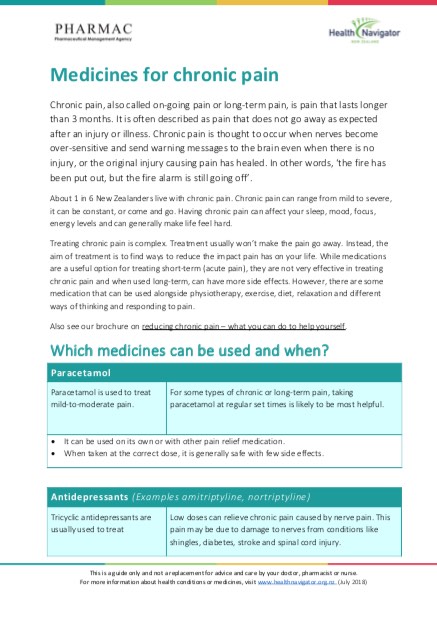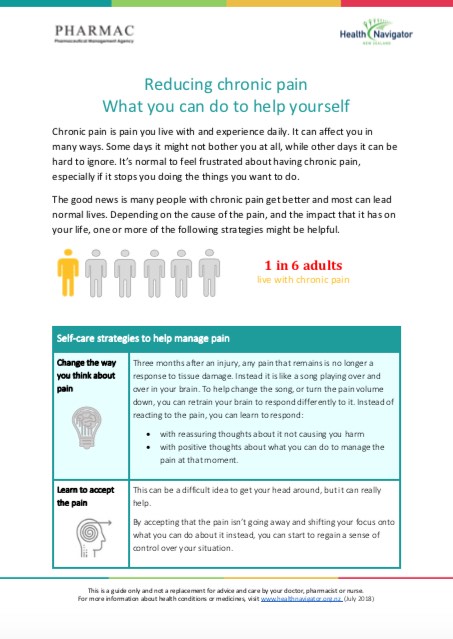Wishing everyone happy holidays and a joyful New Year from the Healthify team. Don't forget to Slip, Slop, Slap and Wrap!
Pain relief medicines for chronic pain
Key points about pain relief medicines for chronic pain
- Some commonly used pain relief medicines aren't very effective in treating chronic pain and, when used long term, can have harmful side effects.
- Treating chronic pain is complex and treatment with medicines usually won’t make the pain go away.
- The aim of treatment is to find ways to reduce the impact pain has on your life.

Chronic pain, also called persistent pain or long-term pain, is pain that lasts longer than 3 months. It’s often described as pain that doesn’t go away as expected after an injury or illness.
- The aim of treatment is to find ways to support you, reduce the impact of the pain on your life and increase your ability to do the things you want to do.
- Effective management of chronic pain requires a full assessment of your pain and its impact on your life. This may include assessments by a pain medicine specialist, movement therapist (eg, physiotherapist, osteopath) occupational therapist and psychologist.
Medicines can be part of your pain management plan but, in general, medicines such as opioids aren't very effective for reducing chronic pain and often have unpleasant side effects.
Medicines should be just one part of managing pain effectively and should be used alongside other strategies. These may include:
- physiotherapy
- exercise
- a balanced diet
- relaxation
- different ways of thinking and responding to pain (mindfulness and cognitive behaviour therapy)
- other non-medicine treatments such as electrical stimulating techniques (TENS machine) and acupuncture.
The aim of using medicines is to support how you can take part in physical and psychological therapy.
- Some types of chronic pain don't respond to medicines used for acute pain.
- Treatment with medicines usually won’t make the pain go away.
- Using a combination of medicines together can be more effective and cause fewer side effects than using a high dose of just 1 medicine. This allows each medicine to work at a lower, safer dose.
-
The medicines used for chronic pain depend on the cause of the pain.
Read more about chronic pain and reducing chronic pain – what you can do to help yourself [PDF, 210 KB].
Note: the information on this page is for medicines used in chronic pain. For information about acute pain, see pain relief medicines for short term pain.
If you're using medicines for chronic pain, it's a good idea to develop a pain management plan(external link) with your healthcare provider, which can be discussed and then written down. This plan should provide you with clear guidance on how to use your medicines correctly, including:
- the dose and how often to take them
- when or if you can increase the dose
- common side effects
- how to reduce the dose and stop medicines as your pain improves.
It should also include a review schedule. For any medicine being used for chronic pain, contact your doctor or nurse prescriber 2 to 4 weeks after starting it or after any dose changes to see if there's been any response or if you have any side effects.
The full effect of medicines may take up to 3 months to be felt. This can be longer for people who are sensitive to side effects and require a slow increase in the dose of the medicine.
You may need to try a few different medicines, together with other non-medicine treatments, to find which combination works best for you.
This type of pain is the most common type of chronic pain and usually feels like an ache in the affected area which can be dull or throbbing. The pain is caused by tissue damage or inflammation that often happens after an injury. This pain is also known as nociceptive pain. Examples are arthritis or lower back pain from a disc prolapse.
Talk to your healthcare provider about how to take your medicines. As a general guide, if the pain comes and goes and doesn’t impact on your daily life very much, you can take medicines only when you have pain. For example, if you know certain activities such as playing tennis make the pain worse, then taking medicine before you play can be helpful.
If your pain is always there, talk to your healthcare provider, they may advise you to take your medicine regularly.
Paracetamol
Paracetamol is used to treat mild-to-moderate pain. For some types of chronic or long-term pain, taking paracetamol at regular set times, eg, every 6 hours, is likely to be most helpful.
- It can be used on its own or with other pain relief medication.
- When taken at the correct dose, it's generally safe with few side effects.
- Don’t take more than the advised dose. For adults this is usually up to a maximum of 8 tablets (500 mg) in 24 hours, or 6 slow-release tablets (665 mg) in 24 hours.
Read more about paracetamol.
Non-steroidal anti-inflammatories (NSAIDs)
NSAIDs can be used for a short time when you have a flare-up of symptoms caused by inflammation. Examples are Ibuprofen slow release (Brufen®), Diclofenac slow release (Voltaren®), Celecoxib (Celebrex®) and Naproxen slow release (Naprosyn SR®).
- These medicines treat inflammation and this isn't often the cause of chronic pain.
- Only use NSAIDs regularly or long term if prescribed by your healthcare provider as they can have harmful side effects. You’ll need to have regular check-ups with your doctor and blood tests to make sure they're not harming your kidneys.
- You may be prescribed another medicine while taking NSAIDs to protect your stomach, eg, omeprazole.
- Extra care is needed if you have high blood pressure, high cholesterol, you smoke or have cardiovascular disease (heart disease). NSAIDs can increase the chance of a heart attack or stroke.
- If you have diabetes, your kidneys don’t work very well or you're dehydrated from vomiting (being sick) or diarrhoea (runny poo), tell your healthcare provider before taking NSAIDs. The combination of one of these conditions and NSAIDs can damage your kidneys. The risk increases the longer you take an NSAID.
- If you’re on other medicines for your heart or blood pressure you need to take extra care with NSAIDs. Read more about the triple whammy(external link).
- NSAIDs are also available as gels or creams that can be bought over the counter to be massaged into the painful area.
Read more about NSAIDs and NSAID gels.
Capsaicin cream
Capsaicin cream is available in 2 strengths and the lower strength of 0.025% (Zo-Rub Osteo®, Zostrix®, Rugby 0.025%®) can relieve pain from osteoarthritis.
- It needs to be applied, but not massaged into, the areas regularly – 3 to 4 times a day.
- It can take 1 week to notice any difference and up to 6 weeks to reach its full effect.
Read more about capsaicin.
Steroids
Some steroids are used for pain relief by reducing swelling and inflammation when other pain relievers aren’t suitable or effective alone. Examples are prednisone, triamcinolone (Kenacort-A®), methylprednisolone acetate (Depo-Medrol®) and dexamethasone.
- Steroids can be given either by injection, for painful arthritis or tendinitis, or as tablets.
- They are best used when inflammation is the main cause of pain. They are potent anti-inflammatories, but don’t have any other pain-relieving effect.
- They may provide short-term pain relief, but don’t improve joint function or stiffness.
- Low doses of steroids may give relief from pain and stiffness for people with conditions such as rheumatoid arthritis. Short-term use of higher doses may help you with a severe flare-up of arthritis.
- Side effects such as weight gain, thinning of your skin and bruising more easily can happen with high doses and long-term use (for a few months to several years). If steroids are used in small doses or for a short time, these side effects are less likely.
Nerve pain is caused by injury to your nerves or nervous system and feels like burning, shooting or tingling in the affected areas. It can be constant or come and go. Examples are sciatica or pain after a shingles infection, with diabetes, multiple sclerosis or after a stroke.
Antidepressants and gabapentinoids should be taken regularly to prevent the pain by dampening down the excitability in the nervous system.
To work effectively they must be taken every day, even when you don’t have the pain. Taking them only when you need pain relief won’t work.
If you don’t feel any improvement in your pain after 6 to 8 weeks, talk to your healthcare provider.
Antidepressants
These medicines are usually used to treat depression but low doses can be used to treat nerve pain caused by shingles, diabetes, stroke and spinal cord injury. Antidepressants are not approved for this use in Aotearoa New Zealand. Examples are amitriptyline and nortriptyline (Norpress®).
- Some antidepressants have also been found to improve sleep and help with relaxation.
- Your doctor will start you on a low dose and increase the dose slowly if you need it.
- Antidepressants don’t start working immediately – it can take a few days for you to notice the pain relief effects.
- If tricyclic antidepressants help your pain, you can continue to take them for as long as you need to, but don’t take any more than the amount prescribed without talking to your doctor first.
- Don't stop taking these medicines suddenly. Talk to your doctor before stopping. It's best to stop taking antidepressants slowly.
- Many people experience side effects with tricyclic antidepressants, including drowsiness, constipation and dry mouth. Tell your doctor if these bother you. Don't drink or drive alcohol if you feel drowsy.
Gabapentinoids
These medicines can be useful for nerve pain but don't work for everyone. Examples are gabapentin (Nupentin®) and pregabalin.
- Your doctor will start you on a low dose and increase the dose slowly, to allow your body to get used to the medicine.
- It can take a few weeks for you to notice the full pain relief effects of gabapentinoids.
- Don't use them for other types of pain.
- They're not recommended to be taken together with opioids.
- If gabapentinoids help your pain, you can continue to take them for as long as you need to.
- Don’t stop taking them suddenly without your doctor's advice.
- Let your doctor know if you have a history of substance abuse or depression.
- Don’t start any new medicines without talking to your doctor first to make sure they are safe to take together with gabapentinoids.
Capsaicin cream
Capsaicin cream is available in 2 strengths and the stronger 0.075% strength (Zo-Rub HP®, Zostrix HP®, Rugby 0.075%®) can relieve pain from shingles and nerve pain from diabetes.
- Don’t apply it to broken skin or shingles lesions until the lesions have healed.
- It needs to be applied (but not massaged in) regularly, 3 to 4 times a day.
- It can take 1 week to notice any difference and up to 6 weeks to reach it’s full effect.
Read more about capsaicin.
Lignocaine gel (Emla®, Numit®)
Lignocaine is a local anaesthetic that numbs the area. It can help block the nerves causing the pain. Read more about numbing (anaesthetic) gel or cream.
This type of pain is also known as nociplastic pain and is due to increased sensitivity caused by changes in how your nervous system processes sensory information.
The pain is often felt over your whole body and can be constant or come and go. There may also be other symptoms of tiredness, poor sleep and difficulty concentrating. Examples are fibromyalgia and irritable bowel syndrome.
This type of pain is less likely to respond to pain medication.
Antidepressants
These medicines are usually used to treat depression but low doses can relieve some types of chronic pain. Antidepressants are not approved for this use in Aotearoa New Zealand. Examples are amitriptyline and nortriptyline (Norpress®).
- Some antidepressants have also been found to improve sleep and help with relaxation.
- To work effectively, tricyclic antidepressants must be taken every day, even when you don’t have pain. Taking them only when you need pain relief won’t work.
- Your doctor will start you on a low dose and increase the dose slowly if you need it.
- Antidepressants don’t start working immediately – it can take a few days for you to notice the pain relief effects.
- If tricyclic antidepressants help your pain, you can continue to take them for as long as you need to, but don’t take any more than the amount prescribed without talking to your doctor first.
- Don't stop taking these medicines suddenly. Talk to your doctor before stopping. It's best to stop taking antidepressants slowly.
- If you don’t feel any improvement in your pain after 6 to 8 weeks, talk to your healthcare provider.
- Many people experience side effects with tricyclic antidepressants, including drowsiness, constipation and dry mouth. Tell your doctor if these bother you. Don't drink or drive alcohol if you feel drowsy.
Noradrenaline reuptake inhibitors (NRIs)
Using these medicines for nociplastic pain isn’t officially what they are approved to be used for in Aotearoa New Zealand. However, they can be tried if nothing else has worked. Talk to your doctor about these. Examples of NRIs are venlafaxine (Enlafax XR®), mirtazapine and bupropion (Zyban).
Clonidine
This medicine isn't officially approved for nociplastic pain management in Aotearoa New Zealand, but it can be tried if nothing else has worked. Talk to your doctor about this. Read more about clonidine.
Opioids can be used to treat chronic pain caused by cancer. They're not recommended for other types of ongoing pain because there’s no evidence they’re effective and they can cause more harm over time. Examples are codeine, tramadol, morphine, oxycodone and fentanyl.
- Some people experience unpleasant side effects such as constipation (difficult to pass bowel movements), nausea (feeling sick), dizziness and sleepiness. You may be prescribed other medicines for nausea and constipation to help with these side effects.
- Read more about opioids and opioids in palliative care.
Medicinal cannabis
Scientific evidence for the effective and safe use of cannabis-based products isn’t strong, and is still emerging. There's limited research into the use of medicinal cannabis and weak evidence of its effect in reducing chronic pain. In general, there’s not enough information yet to fully recommend the use for cannabis-based products for chronic pain, but some people do experience relief with these products.
Read more about cannabis-based products.
Naltrexone
Some small studies suggest low doses of naltrexone may be helpful for chronic pain but there's no evidence of this on a larger scale. More information is needed before this medicine can be approved for use for chronic pain.
Brochures
Medicines for chronic pain(external link) Healthify He Puna Waiora, NZ and PHARMAC, NZ, 2018
Reducing chronic pain – what you can do to help yourself(external link) Healthify He Puna Waiora, NZ and PHARMAC, NZ, 2018
Pain management plan(external link) BPAC, NZ, 2022
5 questions to ask about your medications(external link) Health Quality and Safety Commission, NZ, 2019 English(external link), te reo Māori(external link)
Apps
References
- Pain(external link) New Zealand Formulary, NZ
- Analgesics(external link) New Zealand Formulary, NZ
- The principles of managing acute pain in primary care(external link) BPAC,NZ, 2018
- Prescribing gabapentin and pregabalin: upcoming subsidy changes(external link) BPAC, NZ, 2018
- Managing patients with neuropathic pain(external link) BPAC, NZ, 2016
- Helping patients cope with chronic non-malignant pain – it's not about opioids(external link) BPAC, NZ, 2014
- Understanding the role of opioids in chronic non-malignant pain(external link) BPAC, NZ, 2018
- Spotlight on gabapentin and pregabalin for neuropathic pain(external link) Medsafe, NZ, 2021
- Unintentional misuse of prescription medicines(external link) BPAC, NZ, 2024
Brochures

Healthify He Puna Waiora, NZ and PHARMAC, NZ, 2018

Healthify He Puna Waiora, NZ and PHARMAC, NZ, 2018

Pain management plan
BPAC, NZ, 2022
Credits: Sandra Ponen, Pharmacist, Healthify He Puna Waiora. Healthify is brought to you by Health Navigator Charitable Trust.
Reviewed by: Stephanie Yee and Angela Lambie, Pharmacists, Auckland; Dr Emma Dunning, Clinical Editor and Advisor.
Last reviewed:





